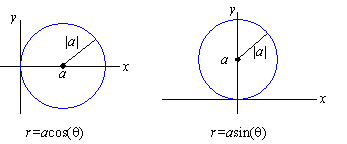
If we are given a curve in the xy-plane, then the identities x = rcos( q) and x = rsin( q) can be used to pull the curve back into polar coordinates. For example, x2+y2 = R2 is pulled back into polar coordinates by substituting x = rcos( q) and x = rsin( q) :
|
Similarly, lines of the form y = mx become
|

In general, the pullback into polar coordinates of a curve in xy-coordinates is the result of substituting x = rcos( q) and x = rsin( q) into the equation of the curve and simplifying. The identity x2+y2 = r2 is also often used in converting the xy-equation of a curve into polar coordinates.
EXAMPLE 6 Convert the curve x2+y2 = 2x into polar coordinates.
Solution: To do so, we replace x2+y2 by r2 and let x = rcos( q) :
Solving for r then yields
r2 = 2rcos( q)
r = 2cos( q)
The curve x2+y2 = 2x, and correspondingly its pullback r = 2cos( q) into polar coordinates, is a circle of radius 1 centered at ( 1,0) . In general, a curve of the form r = 2acos( q) is a circle of radius | a| centered at ( a,0) and a curve of the form r = 2asin(q) is a circle of radius | a| centered at (0, a) .

Let's look at another example.
EXAMPLE 7 Find the pullback of y = 2x+1 into polar coordinates.
Solution: To do so, we let x = r cos(q) and we let y = r sin(q) :
Solving for r then yields
r sin(q) = 2r cos( q) + 1 r sin(q) - 2r cos(q) = 1
r =
1 sin(q) - 2cos(q)